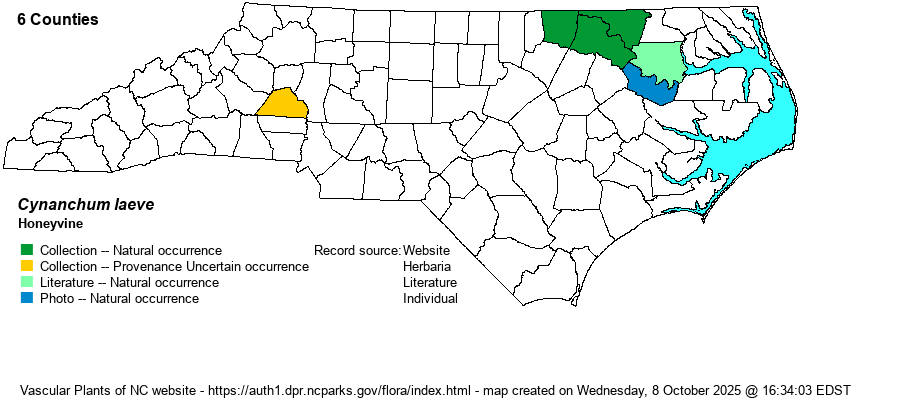| Author | (Michaux) Persoon | |
| Distribution | Occurs only along or close to the Roanoke River floodplain, from Warren County downriver to the Williamston area of Bertie and Martin counties. A specimen from Catawba County is considered of uncertain provenance, owing more to unlikely habitat rather than to range. Note that the species has a broad range north and south of NC and there is little reason why it should only be found natively along this river. However, Weakley (2024) now states that "The native vs. adventive portions of the distribution are difficult to determine; we here treat the distribution east of the Appalachians as likely introduced." However, for the time being, the editors are considering the Roanoke River population as native, especially as the Digital Atlas of Virginia Flora maps all counties as native.
This species occurs mostly to the west of NC, though it ranges widely across most of VA. It ranges from southern PA south to the FL Panhandle, with scattered records in SC. Why the range "stops" in the Piedmont at the VA/NC line is very odd, but it is certainly not owing to a lack of field work in northern Piedmont counties in NC.
| |
| Abundance | Infrequent to locally fairly common along the Roanoke River, upriver from Williamston. Essentially absent elsewhere, though it would be expected to be found in a natural setting elsewhere in the state in upcoming years, especially in the northern Piedmont. The NCNHP considers it as a Watch List species, but has moved it from W7 to W4 in 2024, following Weakley's suggestion that the NC populations might not be native. NCNHP also re-ranked it as SU (Undetermined), from S1?. The website authors maintain that the rank should be S1? but likely native, at least along the Roanoke River (and thus not W4). | |
| Habitat | This is a wetland species, found mostly along the margins of bottomland and natural levee forests, but it also occurs in various other openings along the river, such as in damp thickets very close to the river. Most known sites are, indeed, within view of this brownwater river. |
| Phenology | Blooms in July and August, and fruits in September and October. | |
| Identification | This is a quite long and slender herbaceous vine, sprawling and climbing over other vegetation to a height of over 6 feet high/long. It has opposite leaves that are ovate-triangular, with distinct basal lobes, but it is the shape of the base that is critical for identification. In this species the leaf base is not cordate (V-shaped), but is widely rounded, like a thumbprint. The leaves are dark green and a bit leathery, looking almost like an evergreen species; leaves are about 4 inches long and about 2 inches wide near the base, tapering to a narrow and pointed apex. A number of other vine species have ovate-triangular leaves, but perhaps only this one has a broadly rounded, thumb-like base. If in doubt, break off a leaf at its base, and look for the white milky sap. Various other species -- such as morning-glories (Ipomoea spp.) and Climbing Hempweed (Mikania scandens) -- lack the milky sap, whereas Matelea species (which do have milky sap) have leaf bases that are cordate. Helping to identify this potentially confusing species are the flowers and pods. This species has small clusters of pale yellow to creamy-white flowers in leaf axils, and each cluster is about 1-inch across. Later in the season, the large pods appear; these capsules are long and narrow, but are smooth on the surface, and are about 6 inches long and 1-inch wide. In searching for this scarce species in the state, you will have to be very vigilant; there are quite a few climbing vines with ovate-triangular leaves that have pointed tips. Many of these will not have flowers or fruit, and thus you must check 1) to see if it has milky sap, and then 2) to see if the leaf base is rounded between the two lobes and is not V-shaped. | |
| Taxonomic Comments | Though RAB (1968) has it named as Cynanchum laeve, as does Weakley (2018), it has gone by Ampelamus albidus in some references.
| |
| Other Common Name(s) | Sandvine, Bluevine, Honeyvine Milkweed, Bluevine Milkweed, Smooth Swallowwort | |
| State Rank | SU [S1?] | |
| Global Rank | G5 | |
| State Status | W4 [W7] | |
| US Status | | |
| USACE-agcp | FAC link |
| USACE-emp | FAC link |

